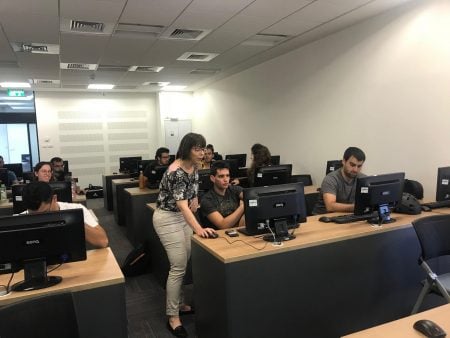 Dorit van-Moppes is unique for a STEM librarian: she actually started as a biotech scientific researcher before starting her current career. She is in the Zalman Arrane Library, Ben-Gurion University of the Negev, Beer-Sheva, Israel. Van-Moppes unique career background has given her special insights into interaction with her campus’ students, teachers and researchers. So successful has van Moppes been in her outreach efforts, she won a JoVE travel award to attend the Charleston Library conference in November, along with three other colleagues (from the U.S. and France).
Dorit van-Moppes is unique for a STEM librarian: she actually started as a biotech scientific researcher before starting her current career. She is in the Zalman Arrane Library, Ben-Gurion University of the Negev, Beer-Sheva, Israel. Van-Moppes unique career background has given her special insights into interaction with her campus’ students, teachers and researchers. So successful has van Moppes been in her outreach efforts, she won a JoVE travel award to attend the Charleston Library conference in November, along with three other colleagues (from the U.S. and France).
Tell us about your background, and how that has influenced your outreach approach.
I came to the library science field from the scientific research arena. So I bring a somewhat different view of the role of the research institute library. I see the library not only as an information resource for students and researchers, but also as something providing a teaching framework for the students — particularly those studying the Science, Technology, Engineering, and Mathematics disciplines. My perspective derives from, and continues to be colored by, my personal journey from Master of Science in life sciences to an Master of Arts in information science. I went from manager of a large laboratory of undergraduate and graduate students (developing the biotechnology for bio-products from red microalgae) to the STEM floor of the Zalman Arrane Library, Ben- Gurion University of the Negev. Here, I see it as my mission to leverage my two areas of knowledge to contribute to the university's education and research effort.
Can you talk about some of the unique outreach challenges at your school?
To establish the context for presenting the challenges facing me as a “STEM librarian,” I need to say a word about the university and its student population. One of Israel’s leading research universities, Ben-Gurion University is home to approximately 900 faculty members and 20,000 students, with about half the student body studying STEM subjects (in the faculties of engineering and natural Ssiences). The student population is unique in terms of its language skills: The first language of these students — drawn from all sectors of Israel's population, both Jewish and Arab (including Bedouins) — ranges from Hebrew or Arabic, through the myriad of different languages of the students’ respective immigrant roots. The common denominator uniting these students is thus that English is not their mother tongue. Nonetheless, they are required to acquire literacy skills in the language of technological communication — English — a requirement that poses challenges to students and librarians alike!
What can librarians do about this?
One of the main problems (possibly deriving partly from the students' level of English competency) facing librarians as educators is the lack of motivation on the part of STEM students to internalize the principles of searching and evaluating information. This is despite their relatively advanced technological capabilities. Instead, they rely primarily on Google and Google Scholar as search engines. The challenges for libraries in general (and STEM-discipline libraries in particular) are therefore to remain relevant and become integral players in student studies. Within this scenario, my task as a STEM librarian is to develop and run a set of tutorials using library resources and tailored to the needs of STEM students during their three to four years of undergraduate studies — and beyond.
And so you turned to JoVE, among other methods?
One of the most important tools at my disposal for teaching them how to find and filter information is JoVE. It provides a visual display of academic material of high quality and reliability in a large variety of STEM fields. Importantly, I have found that tutorials starting with JoVE videos promote increased interest in the use of other databases and reduce the level of anxiety in using them.
Can you elaborate on how you succeeded?
The first tutorial that I and my fellow librarians developed was designed to introduce the library to students in the university's one-year preparatory program for STEM studies. The tutorial provides students with an initial acquaintance with the library's homepage, familiarization with the locations of books covering STEM topics, and an introduction to primary databases for articles in English or Hebrew. I then designed tutorials for first- and second-year students to aid them in writing laboratory reports, which require not only a description of the relevant experiments but also background material from the literature. These tutorials are based primarily on JoVE videos, which are my tools of choice for the initial exposure of students to the entire academic information world. I teach the students how JoVE videos explain laboratory protocols, methods and scientific techniques. Also, that when used together with databases like SciFinder and Scopus, JoVE will aid them in writing the best possible laboratory reports. For example, JoVE videos explain clearly and academically — through visual means accompanied by written explanations — the standard laboratory procedure for using a pH meter and constructing a calibration curve. The understanding of the basic science and the technicalities of the laboratory procedures gained via the JoVE videos aids the student to better understand the meaning of pH.
You use JoVE extensively, then?
In the final year of their undergraduate studies (third or fourth years), STEM students must perform a research project that involves laboratory work, a scientific literature review, an oral presentation of progress, and a final written research report. My scientific view is that the research project, in all its tasks, is a critical factor in the making of a new scientist. In my role as a librarian, I therefore initiated cooperation with the STEM departments to create a set of training tutorials tailored to departmental needs, in terms of content and time frame. The comprehensive research tutorials that were developed focused on teaching the students how to find and select relevant STEM material from the entire trove of JoVE science education tools, together with other relevant databases. In the opinion of the supervising scientists, these tutorials helped the STEM students to succeed in all four tasks associated with their projects, and made a significant contribution to the quality of the projects.
Can you elaborate more on the librarian role you play?
As a STEM librarian, I also give individual and group training to graduate students and researchers. Here, too, the duality of my professional backgrounds influences my outreach activities: I am acutely aware that one of the most important issues in a researcher's career is the quality of the journals in which the researcher publishes. I therefore run tutorials for researchers and graduate students about the importance of Impact Factor (IF) and Quartile (Q) ratings in their choice of journals in which to publish, and how to reach a high H-index.
And what is coming for your library?
Most of the training sessions that I have described take place in the different departments, but not in the library. My vision for the future is to move these — and other yet-to-be-developed — tutorials to the library, with the aim of bringing the students closer to the library, as an ever-evolving source of help and support during their studies.


